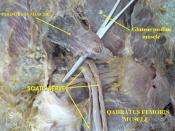A patient suffers a cerebral vascular accident (stroke) which damages part of his primary motor cortex leaving his left leg paralysed. A second patient suffers an automobile accident in which his left sciatic nerve is severed, paralysing his leg.
Describe and contrast the effects on the leg muscles of these two injuries, including a description of the pathways involved.
Patient A is suffering from an upper motor neuron lesion due to stroke, also known as a cerebrovascular accident (CVA), a stroke is a life-threatening event in which part of the brain is deprived of adequate oxygen. Strokes are extremely dangerous, accounting for more than 160,000 deaths in 2001, according to the American Heart Association. Stroke is the third leading cause of death in the United States, behind heart disease and cancer. It is also a leading cause of adult disability and institutionalization
Fig1. [reference 5]
There are two kinds of strokes.
An ischemic stroke , which accounts for more than 88% of stroke occurs when the blood supply to the brain is interrupted, usually by a blood clot (thrombosis). These clots may be caused by "hardening of the arteries" (atherosclerosis) in the carotid arteries, which feed the head and brain with oxygen-rich blood. The second kind of stroke is a hemorrhagic stroke, which occurs when there is excessive bleeding (haemorrhaging) within or around the brain. Bleeding within the brain is known as a cerebral haemorrhage which is often due to complication of high blood pressure. Bleeding around the brain is known as subarachnoid haemorrhage, which could be caused by ruptured cerebral aneurysm, a head injury or other causes.[reference 5]
After a stroke begins, it is imperative that people seek treatment as soon as possible to re-establish the flow of oxygen-rich blood to the brain cells before permanent tissue damage or...

![May E. Miller - Trungeon [i.e., Trudgeon] stroke (LOC)](https://s.writework.com/uploads/7/76000/may-e-miller-trungeon-e-trudgeon-stroke-loc-thumb.jpg)
